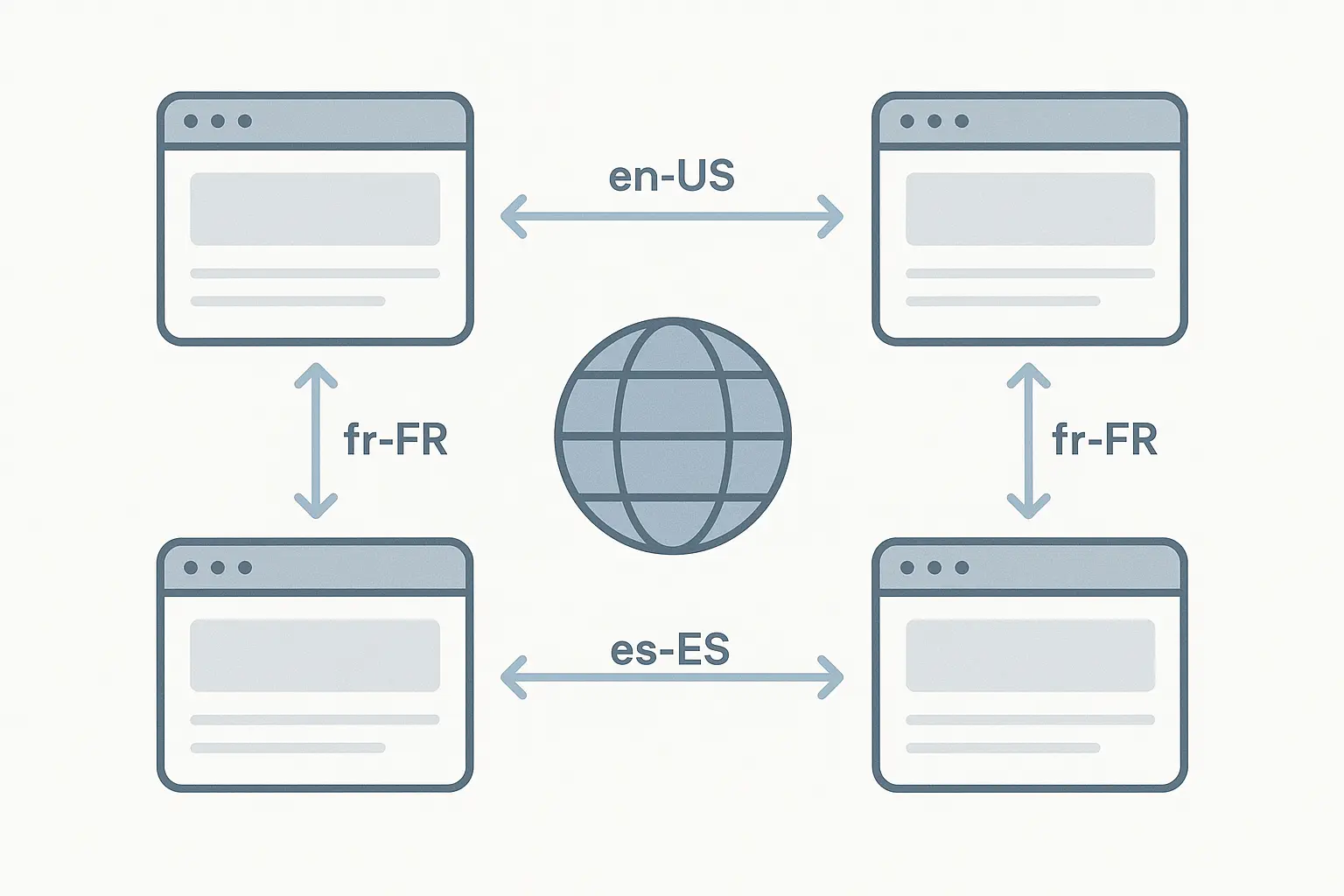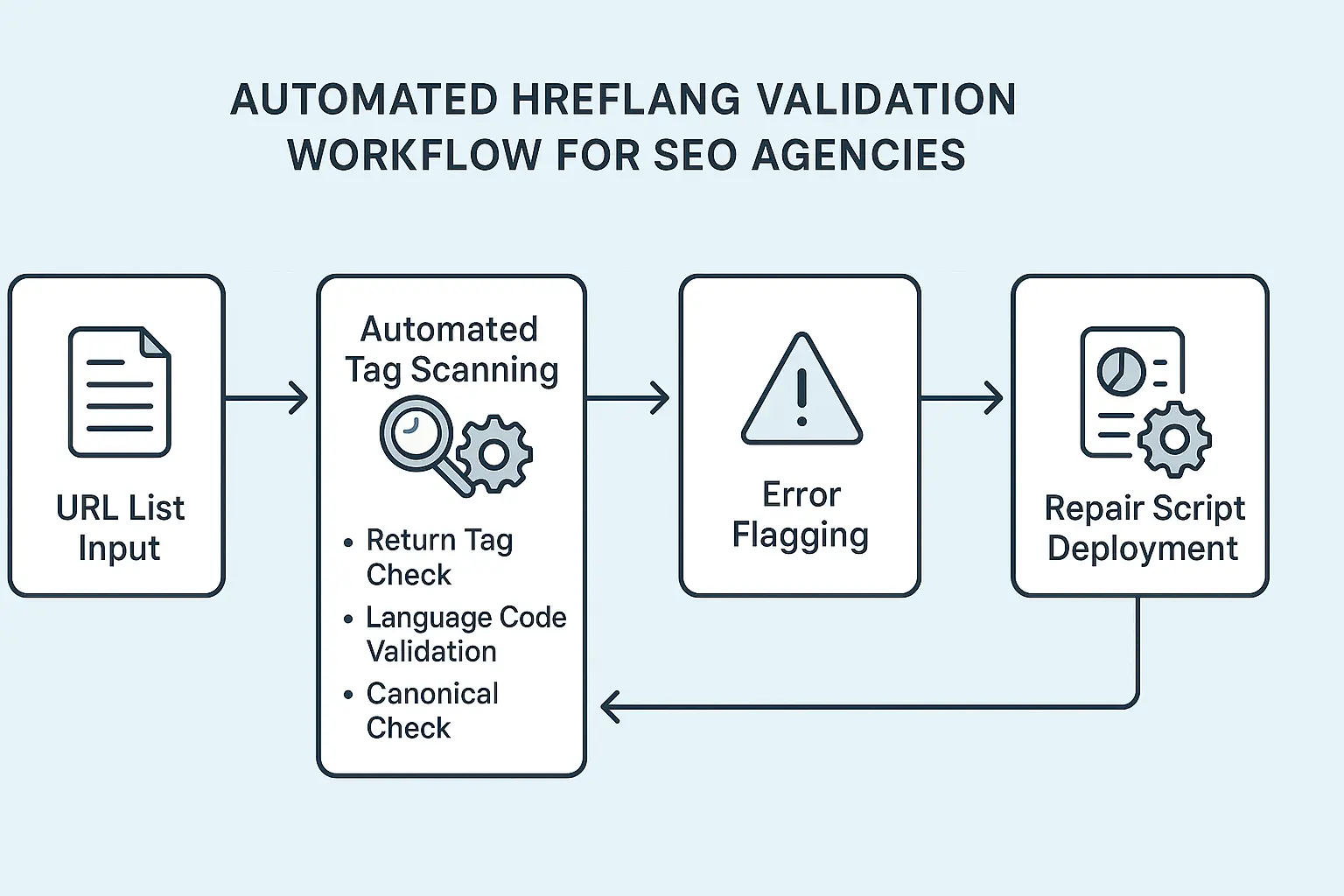Imagine this: your agency just launched a beautiful, fully translated website for a client in France. The launch was a success, the client is thrilled, and your team celebrates a job well done.
A month later, you’re looking at the analytics. Traffic to the original US site has dipped. Conversions are down. Panic sets in. After hours of frantic digging, you find the culprit: a tiny line of code. A missing hreflang tag on the US homepage failed to “point back” to the new French version.
The result? Search engine confusion. Google started showing French searchers the US site and, even worse, sometimes showing US searchers the French site. This isn’t a hypothetical scenario; it’s a common and costly reality for agencies managing international clients. According to Google’s own John Mueller, “Hreflang implementation issues like missing return tags are a very common problem area.”
These small errors are silent traffic killers. They don’t crash your site or throw up obvious 404 errors. They quietly erode your client’s global search presence, sending the right customers to the wrong digital storefront. And with 75% of consumers preferring to buy products in their native language, sending them to the wrong version is like closing the door in their face.
What Are Hreflang Tags, Really? A Simple Analogy
Let’s demystify hreflang. Think of your website as a global chain of stores. You have a store in New York (your en-us site), one in London (en-gb), and one in Mexico City (es-mx).
Hreflang tags are the friendly, multilingual concierges standing outside each store.
When a searcher from London asks Google for “running shoes,” the concierge for the New York store politely says, “Ah, you’re from the UK! Our London store over there has the same great shoes, but with pricing in pounds and local shipping info. You’ll be much happier there.”

Without these “concierges,” Google is left to guess. It might send the Londoner to the New York store, where they’ll be confused by dollar signs and expensive international shipping. That’s a poor user experience, and Google knows it. That’s why getting hreflang right is non-negotiable for any business operating across borders, especially when 77% of global searchers use Google to find information.
The Three Horsemen of Hreflang Errors
Manually managing hreflang tags across dozens—or even hundreds—of pages is a recipe for disaster. The problem isn’t just the initial setup; it’s the ongoing maintenance. A single content update or URL change can break the entire system. Human error is almost inevitable, and as research shows, it’s the root cause of the vast majority of technical issues.
Here are the three most common—and damaging—errors that can fly under the radar.
1. The Missing Return Tag (The One-Way Street)
This is the most common hreflang error. It happens when Page A (e.g., your en-us version) links to Page B (your de-de version), but Page B doesn’t link back to Page A.
The Rule: Hreflang annotations must be reciprocal. It’s a two-way confirmation. If one page doesn’t confirm the relationship, Google ignores the signal entirely.
Why It Happens: A developer might add the new German URL to the US page’s code but forget to update the template for the German page to include a link back. It’s a simple oversight with significant consequences.
2. The Wrong Language/Region Code (The Faulty GPS)
The format for hreflang tags is strict: language-country. The language must be in ISO 639-1 format (e.g., en, es, fr), and the country must be in ISO 3166-1 Alpha 2 format (e.g., GB, MX, CA).
The Rule: You must use the correct, standardized codes.
Why It Happens: It’s easy to make a typo or use an incorrect convention. A classic mistake is using en-UK for the United Kingdom. The correct code is en-GB. It seems minor, but to Google, en-UK is an invalid signal. You’ve just given it faulty GPS coordinates.

3. The Canonical Contradiction (The Mixed Signals)
This is a more technical, but equally devastating, error. It occurs when a page sends two conflicting messages to Google.
A canonical tag says: “This page is the one true, master version.”
An hreflang tag says: “This page is the English version, but there’s an alternate German version over there.”
The Rule: If a page en-us has a canonical tag pointing to itself (which is common and correct), all its alternate language versions (de-de, fr-fr) must also have a canonical tag pointing to themselves.
Why It Happens: Sometimes, international pages are set up with a canonical tag pointing back to the “main” en-us page. This tells Google to ignore the international pages and only index the US one, completely defeating the purpose of your international SEO efforts.
The Case for Automation: From Manual Nightmare to Scalable Solution
So how do you check for these errors? The manual approach involves crawling every URL, exporting the HTML, and painstakingly cross-referencing thousands of lines of code in a spreadsheet. This process isn’t just time-consuming and error-prone; it’s simply not scalable for an agency managing multiple international clients.
This is where automation becomes an agency’s superpower.
An automated hreflang validation system works tirelessly in the background, like a 24/7 quality control specialist. It replaces manual spot-checks with a systematic, scalable process. For agencies looking to expand their services, partnering with a white-label SEO partner that has this automation built-in is the fastest way to offer enterprise-grade international SEO without the enterprise-level headcount.
Here’s what an automated workflow looks like:
- Scheduled Crawls: The system automatically crawls all relevant pages on your client’s sites on a recurring schedule (e.g., weekly).
- Tag Extraction: It extracts all hreflang and canonical tags from every page.
- Cross-Validation: The software then checks for the “Three Horsemen”: Does every declared hreflang URL have a return tag? Are all language and country codes valid? Do canonical tags align with hreflang signals, or do they conflict?
- Instant Alerts: If any errors are found, the system generates an immediate report detailing the exact URL, the specific error, and what’s needed to fix it.
 Frequently Asked Questions (FAQ)
Frequently Asked Questions (FAQ)
What exactly is hreflang?
Hreflang is an HTML attribute used to specify the language and geographical targeting of a webpage. It helps search engines serve the correct version of a page to users based on their language and location.
Do I need hreflang if I only target different English-speaking countries like the US, UK, and Australia?
Yes, absolutely. Hreflang is not just for different languages. It’s crucial for signaling to Google that you have different versions of a page for different regions, even if the language is the same. This helps ensure users see localized content with the correct currency, spelling (e.g., color vs. colour), and cultural references.
Can’t I just use a plugin for this?
While plugins can be a good starting point for smaller sites, they often lack the robustness to manage complex, enterprise-level websites. They can conflict with other plugins, introduce their own bugs, and rarely provide the deep validation and automated reporting needed to manage hreflang at scale for high-value clients.
How often should I check my hreflang tags?
Manually, it’s almost impossible to check frequently enough. With an automated system, checks should be run at least weekly, or even daily for very large, frequently updated sites. The goal is to catch errors as soon as they are introduced.
Is it better to put hreflang tags in the HTML head or in an XML sitemap?
Both are valid methods. Placing them in the HTML head is most common, as it keeps the signals with the page itself. For very large sites, however, using an XML sitemap can reduce page bloat and make management easier. The most important thing is to choose one method and use it consistently. Automated validation systems can check either implementation.
Pave the Way for Global Growth
Hreflang isn’t just a line of code; it’s a critical part of a global business strategy. Getting it wrong leaves money on the table and creates frustrating experiences for potential customers. Getting it right unlocks new markets and builds a truly international brand presence.
By moving away from manual, error-prone processes and embracing automation, your agency can stop chasing silent traffic killers and start delivering predictable, scalable growth for your international clients.
Ready to explore more about scaling your agency’s technical SEO capabilities? Discover how to build a foundation for growth with our resources on advanced SEO execution.

